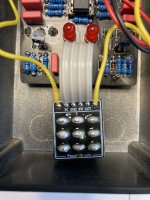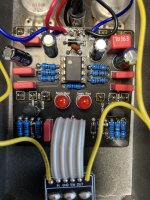seangarland123
Member
My turn to ask for some help. I'm still fairly new to building pedals, and had about 10 pedals that worked great, but suddenly I've been on a bad streak, and this is my 2nd pedal that's got an issue.
Building the Pumbaa Distortion, and I get full sound when bypassed. When engaged, the sound is so low (even when volume and gain are cranked) as to be imperceptible. When playing, I see that both LED's light, then slowly fade with the sound.
Any help would be appreciated!
Building the Pumbaa Distortion, and I get full sound when bypassed. When engaged, the sound is so low (even when volume and gain are cranked) as to be imperceptible. When playing, I see that both LED's light, then slowly fade with the sound.
Any help would be appreciated!



